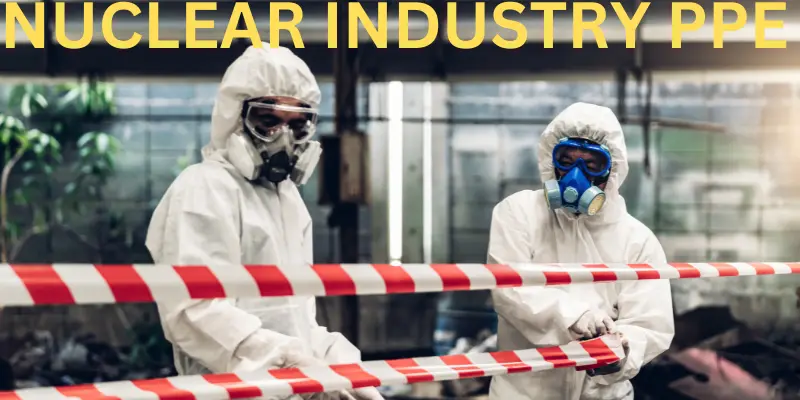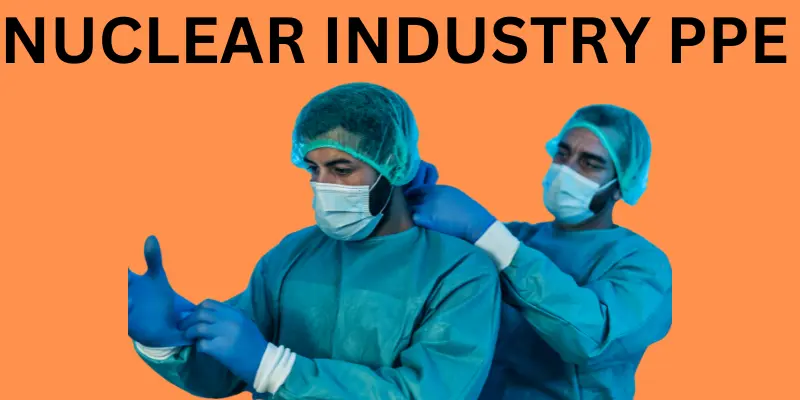Top 10 Nuclear Industry PPE and Manufacturers: The Essential Guide
Updated: 17-Dec-2024
473
Personal Protective Equipment (PPE) refers to specialized clothing and gear designed to protect individuals from hazards in their working environment. In the nuclear industry, PPE is very essential, where workers are often exposed to radiation, toxic chemicals, and other risks, PPE serves as a critical safeguard. By creating a barrier between workers and potential threats, PPE ensures safety while allowing essential operations to continue.

1. Why Nuclear Industry PPE Is So Important
The importance of PPE lies in its ability to mitigate risks that can cause severe harm or even fatalities. In the nuclear industry, where radiation exposure can lead to cancer, genetic damage, or acute radiation syndrome, PPE is a non-negotiable safety measure. Proper use of PPE not only protects individuals but also ensures regulatory compliance, maintains public trust, and minimizes downtime due to workplace incidents. The effectiveness of PPE hinges on selecting the right equipment for the job and ensuring workers are trained to use it correctly.
1. Background of Nuclear Industry PPE
The concept of protective equipment dates back to ancient times when armor was used for combat. Modern PPE, however, evolved during the Industrial Revolution to address workplace hazards. As industries grew more complex, so did the need for advanced protective gear. In the 20th century, advancements in materials science and regulatory frameworks led to the development of specialized PPE for high-risk sectors like nuclear power. Today, PPE incorporates cutting-edge technologies, including smart sensors and radiation shielding, to address the unique challenges of the nuclear industry.
2. Usage of Nuclear Industry PPE: Past, Present, and Future
Past: Early PPE in the nuclear sector was rudimentary, often consisting of basic lead aprons and simple respirators. While these offered some protection, they were bulky and limited in effectiveness.
Present: In today’s nuclear industry PPE is a blend of innovation and practicality. Modern suits are lightweight yet offer superior radiation shielding. Advanced respirators, gloves, and face shields incorporate materials like Kevlar, lead composites, and activated carbon filters to ensure maximum safety. Wearable technology, such as dosimeters and smart helmets, provides real-time data on exposure levels.
Future: The future of the nuclear industry PPE lies in smart technology and nanomaterials. Innovations like graphene-based shields and AI-integrated suits promise enhanced protection and comfort. These advancements will not only increase safety but also improve productivity by reducing fatigue and optimizing workflow.
3. Pros and Cons of Nuclear Industry PPE
Nuclear industry PPE
1. Pros:
- Protects against radiation and hazardous materials.
- Reduces the risk of occupational illnesses.
- Ensures compliance with safety regulations.
- Minimizes downtime due to workplace accidents.
- Enhances worker confidence and morale.
- Adaptable to various tasks and environments.
- Enables safe handling of hazardous materials.
- Prevents contamination of workspaces.
- Includes monitoring tools for real-time safety data.
- Reduces long-term healthcare costs.
2. Cons:
- Can be expensive to procure and maintain.
- May be uncomfortable for extended wear.
- Requires regular training for proper use.
- Needs frequent inspection and replacement.
- Bulky PPE may limit mobility.
- Over-reliance can lead to neglect of other safety protocols.
- Improper fit can reduce effectiveness.
- Some PPE is not recyclable, leading to environmental concerns.
- Can create communication barriers during teamwork.
- Maintenance and storage demand additional resources.
4. Top 10 Nuclear Industry PPE Manufacturing Companies
Introduction to companies
1. 3M
- Location: 3M Center, St. Paul, Minnesota, USA.
- Founded: 1902.
- Staff Strength: Over 90,000 employees worldwide.
- Annual Production: Over 60,000 products across various sectors, including nuclear PPE.
- Introduction: Known for its innovative safety solutions, 3M manufactures PPE such as respiratory protection, safety glasses, and fall protection systems. It is a global leader in technology and materials innovation.
Products:
- Respiratory Protection (e.g., N95 masks).
- Fall Protection Systems.
- Chemical-resistant suits.
- Eye and Face Shields.
- Disposable Gloves.
- Thermal Protective Apparel.
- Hearing Protection.
- Hazard Containment Systems.
- Protective Footwear.
- Chemical Spill Kits.
2. Alpha Safety
- Location: Golden, Colorado, USA.
- Founded: 1986.
- Staff Strength: Approximately 500 employees.
- Annual Production: Specialized in nuclear-grade filtration and containment systems.
- Introduction: Focused on advanced solutions for nuclear safety, Alpha Safety is an industry leader in containment systems and mission-critical cleanup operations.
Products:
- Ventilation Systems.
- Radiation Shielding.
- HEPA Filtration Units.
- Protective Containment Suits.
- Modular Containment Units.
- Criticality Alarm Systems.
- Air-supplied Respirators.
- Fire-retardant coveralls.
- Glovebox Isolation Systems.
- Radioactive Waste Transport Containers.
3. Respirex International
- Location: Redhill, Surrey, UK.
- Founded: 1957.
- Staff Strength: Over 200 employees.
- Annual Production: Supplies PPE to the nuclear and chemical sectors globally.
- Introduction: A leader in chemical and nuclear protective wear, Respirex is renowned for its durable, high-performance products.
Products:
- Gas-tight Suits.
- Splash-proof Coveralls.
- Air-fed Garments.
- Chemical Workwear.
- CBRN Overboots.
- Particulate-resistant Apparel.
- Powered Air Systems.
- Protective Gloves.
- Dielectric Safety Boots.
- Isolator Suits.
4. Ansell
- Location: 111 Wood Avenue South, Iselin, New Jersey, USA.
- Founded: 1929.
- Staff Strength: Over 13,000 employees.
- Annual Production: Produces millions of safety solutions annually.
- Introduction: Known for its innovative protective solutions, Ansell specializes in gloves and apparel for hazardous environments.
Products:
- Chemical-resistant gloves.
- Radiation Shielding Suits.
- High-performance aprons.
- Heat-resistant gloves.
- Disposable Nitrile Gloves.
- Respiratory Masks.
- Cut-resistant Sleeves.
- Protective Hoods.
- Flame-retardant coveralls.
- Decontamination Apparel.
5. DuPont
- Location: Wilmington, Delaware, USA.
- Founded: 1802.
- Staff Strength: Over 34,000 employees.
- Annual Production: Globally recognized for Tyvek® and Nomex® protective fabrics.
- Introduction: A pioneer in advanced material science, DuPont delivers high-quality PPE for nuclear and chemical industries.
Products:
- Tyvek® Coveralls.
- Nomex® Flame-resistant Apparel.
- Arc Flash Protection Gear.
- Chemical Barrier Gloves.
- Heat-resistant Apparel.
- Isolation Gowns.
- Radiation-resistant suits.
- Cleanroom Apparel.
- Safety Footwear.
- Chemical Spill Protection Kits.
6. Honeywell Safety Products
- Location: Charlotte, North Carolina, USA.
- Founded: 1906.
- Staff Strength: Over 100,000 employees.
- Annual Production: Offers extensive PPE for industrial and nuclear markets.
- Introduction: Honeywell provides a wide range of safety solutions, combining advanced technology with robust design.
Products:
- Full-face respirators.
- Gas Detection Systems.
- Thermal-resistant suits.
- Chemical Protective Boots.
- CBRN Masks.
- Fire-retardant gloves.
- Hard Hats with Radiation Protection.
- Ventilation Systems.
- Disposable Coveralls.
- Emergency Decontamination Kits.
7. Dräger
- Location: Lübeck, Germany.
- Founded: 1889.
- Staff Strength: Over 15,000 employees.
- Annual Production: Globally recognized for respiratory protection and gas detection systems.
- Introduction: Dräger is a global expert in safety technology, providing specialized PPE for hazardous environments.
Products:
- Gas Detection Devices.
- Self-contained Breathing Apparatus.
- Emergency Escape Hoods.
- CBRN Suits.
- Thermal Imaging Helmets.
- Air-purifying respirators.
- Radiation Monitoring Tools.
- Protective Boots.
- Flame-resistant gloves.
- Medical-grade isolation gowns.
8. Lakeland Industries
- Location: Huntsville, Alabama, USA.
- Founded: 1982.
- Staff Strength: Over 1,000 employees.
- Annual Production: A leading supplier of industrial safety wear globally.
- Introduction: Lakeland specializes in high-performance apparel for chemical, nuclear, and biological threats.
Products:
- Disposable Coveralls.
- Fire-resistant jackets.
- Chemical-resistant gloves.
- Hooded Respirators.
- Protective Overboots.
- Splash-proof Suits.
- Heat-resistant aprons.
- Radiation-blocking Apparel.
- Ventilated Garments.
- CBRN Protective Kits.
9. Kimberly-Clark Professional
- Location: Roswell, Georgia, USA.
- Founded: 1872.
- Staff Strength: Over 40,000 employees.
- Annual Production: Renowned for its disposable safety gear.
- Introduction: Kimberly-Clark is a trusted name in PPE, providing high-quality products tailored to nuclear environments.
Products:
- Nitrile Gloves.
- Protective Masks.
- Lab Coats.
- Shoe Covers.
- Face Shields.
- Radiation-resistant gowns.
- Hair Caps.
- Chemical-resistant aprons.
- CBRN Isolation Suits.
- Contamination Cleanup Kits.
10. MSA Safety
- Location: Cranberry Township, Pennsylvania, USA.
- Founded: 1914.
- Staff Strength: Over 5,000 employees.
- Annual Production: Leading manufacturer of industrial safety products.
- Introduction: MSA Safety delivers advanced protective gear, with a focus on worker safety in high-risk industries.
Products:
- Respiratory Protection Systems.
- Thermal Imaging Cameras.
- Chemical-resistant boots.
- Radiation Detection Equipment.
- Gas-tight Suits.
- Fire-resistant gloves.
- Head and Neck Shields.
- Eye Protection Gear.
- Heat-resistant Coveralls.
- Emergency Escape Kits.

5. FAQs About Nuclear Industry PPE
- What is the primary purpose of PPE in the nuclear industry? To protect workers from radiation, chemical exposure, and physical hazards.
- What types of PPE are commonly used in nuclear facilities? Lead aprons, respirators, gloves, face shields, dosimeters, and protective suits.
- How often should PPE be inspected? PPE should be inspected before each use and periodically by qualified personnel.
- Can PPE eliminate risks? No, PPE reduces risks but cannot eliminate them; other safety measures are also needed.
- What are dosimeters, and why are they important? Dosimeters measure radiation exposure, helping workers stay within safe limits.
- Is PPE mandatory in all nuclear facilities? Yes, PPE use is mandated by international safety standards and local regulations.
- What are some challenges in using PPE? High costs, discomfort, and the need for regular training.
- How is future PPE expected to improve? Through advancements in smart materials and AI integration.
- What role does PPE play in emergency situations? It provides critical protection during accidents, containing exposure and facilitating safe evacuations.
- How can workers ensure their PPE remains effective? By following proper maintenance, storage, and usage guidelines.
6. Conclusion
Nuclear industry PPE is indispensable in the nuclear industry, safeguarding workers against some of the most severe occupational hazards. From its humble beginnings to the cutting-edge technology of today, PPE continues to evolve to meet the unique challenges of this high-risk sector. While it has its limitations, its benefits far outweigh the drawbacks when used correctly. As technology advances, PPE’s role in ensuring safety, enhancing productivity, and protecting lives will only grow stronger.
Please Write Your Comments